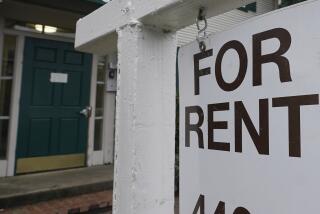Section 8 housing crackdown roils Antelope Valley
- Share via
The name Antelope Valley evokes a picturesque desert-scape where pronghorns once roamed and people now live quietly in rambling homes on spacious lots. But a recent lawsuit suggests a less peaceful image of the cities of Lancaster and Palmdale in the northern reaches of Los Angeles County.
According to the suit, county housing investigators, sometimes accompanied by posses of armed sheriff’s deputies, regularly roust residents on public housing assistance — known as Section 8 vouchers — to see if they are in compliance with the strict rules of the federal housing assistance program. Although the law enforcement officers are legally required to ask permission to enter, their presence is so intimidating that few occupants turn them down.
Those compliance checks have led in many cases to termination of aid. The two cities have had more residents cut off for violations of the Section 8 rules than anywhere else overseen by the Los Angeles County housing authority. Between July 2006 and November 2010, 59% of proposed terminations of aid were in Lancaster and Palmdale, even though those cities are home to just 17% of Section 8 households in the county.
The majority of people on Section 8 assistance in the Antelope Valley — and in Los Angeles County — are black or Latino. The suit, brought by the grass-roots organization Community Action League as well as two unnamed residents and the NAACP, accuses the cities of Lancaster and Palmdale of nothing less than “a deliberate attempt to re-segregate their historically virtually all-white communities.”
The mayors of both Lancaster and Palmdale deny that their cities have engaged in any systematic attempt to drive out Latinos and African Americans. But what is troubling is how aggressive and public officials of both cities have been in resisting the influx of Section 8 participants. In 2009 the cities asked the county housing authority to consider mounting an ad campaign to discourage Section 8 voucher holders from coming to the Antelope Valley because it was too expensive and there were few jobs. The housing authority declined, according to the lawsuit. Lancaster officials also tried to get the U.S. Department of Housing and Urban Development to allow them to withhold city business licenses from landlords who proposed to rent to Section 8 voucher holders. In a 2009 letter, HUD officials turned them down, warning that because 75% of Lancaster’s Section 8 participants were black, the city’s move could be seen as a violation of the Fair Housing Act.
Though it’s true that Lancaster and Palmdale have more Section 8 households than any other community under county housing control, there’s a simple explanation: Housing is affordable and plentiful in the far stretches of the Antelope Valley. Under the program, willing landlords are paid a portion of a voucher holder’s rent by the local public housing authority. The renter pays the rest.
Lancaster Mayor R. Rex Parris says the rising numbers of poor people have taxed city services. He also says the rise in terminations of Section 8 assistance correlates with the city’s drop in crime. But he can’t draw any causality between those phenomena. In fact, crime is down everywhere in Los Angeles County.
After the HUD letter informed him of the ethnic breakdown of Section 8 voucher holders, Parris said publicly: “African Americans comprise 78% of the recipients but are only 20% of the population. That’s unfair.” In a subsequent interview, he said he only meant that there should be an examination of why African Americans make up such a small part of the population of the Antelope Valley but such a large part of its Section 8 participants. It’s no mystery. In Los Angeles County, 47% of Section 8 voucher holders were black and 24% were Latino in 2008. And they went where housing was affordable.
Lancaster and Palmdale requested — and helped pay for — three housing investigators dedicated solely to rooting out Section 8 fraud. To Parris, the dramatically higher rate of fraud in the two cities is just the result of investigators doing a conscientious job. But what Parris sees as conscientious strikes us as overzealous.
It’s time for the cities to pull back on their anti-Section 8 rhetoric. We are all for aggressively cracking down on crime, whether it’s Section 8 fraud or anything else. But Section 8 participants go through rigorous background checks and must adhere to myriad rules. It doesn’t take much to get kicked out of the program, as the Antelope Valley investigators have demonstrated. A visitor who stays with a Section 8 resident one day longer than permitted is considered an unauthorized tenant. Most terminations in Lancaster, according to the lawsuit, were for unauthorized tenancy.
What is unconscionable is a crackdown so broad that it amounts to a campaign of harassment against poor people, most of whom are black, and the landlords willing to rent to them.
Parris’ diatribes only serve to inflame the community. He and other officials should be discouraging harassment of Section 8 voucher holders. As for the strain on public services for the poor, maybe the cities could start financing those resources by diverting the salaries of those extra Section 8 housing investigators.
More to Read
A cure for the common opinion
Get thought-provoking perspectives with our weekly newsletter.
You may occasionally receive promotional content from the Los Angeles Times.










